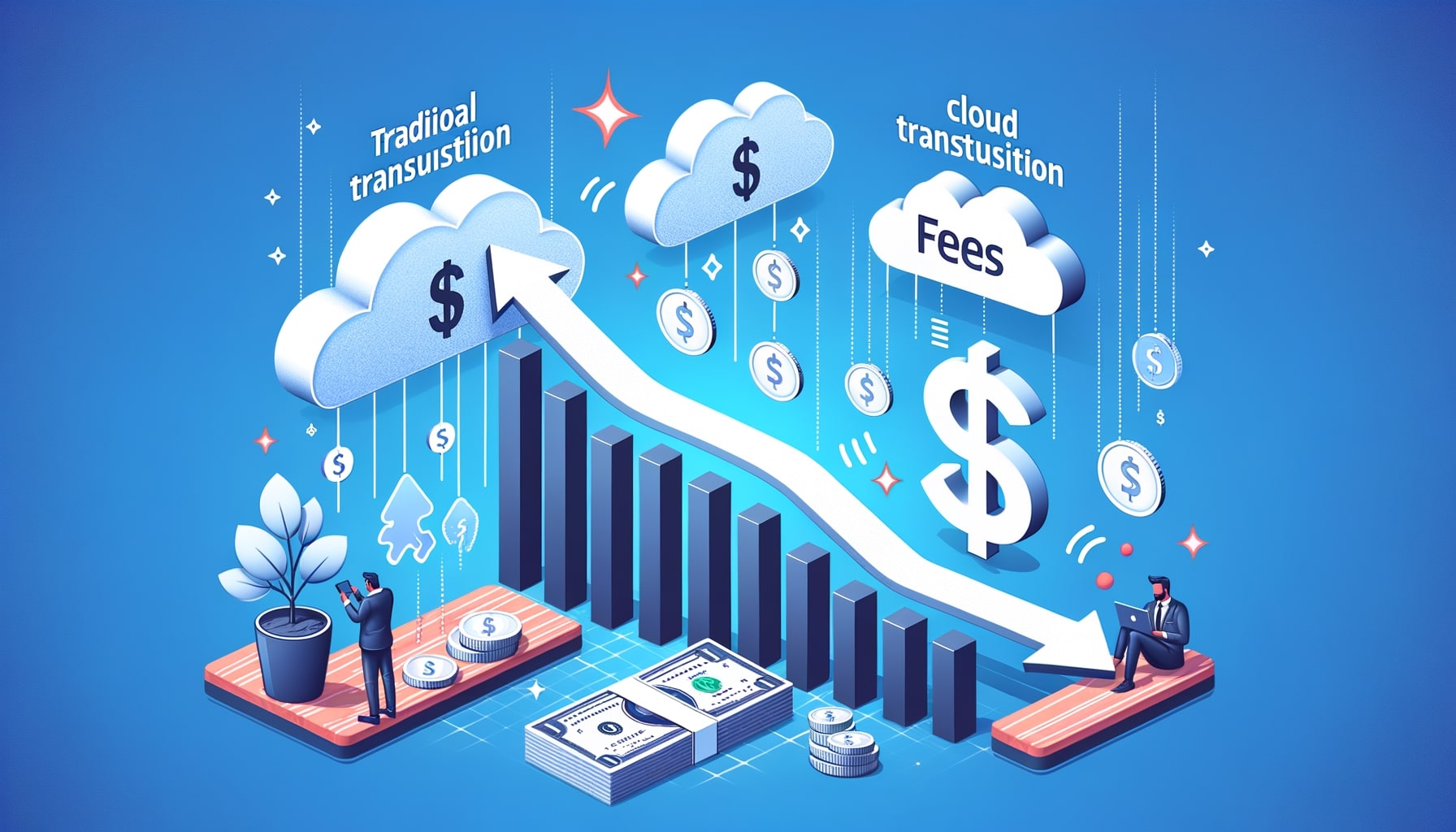How Cloud Payment Processing Reduces Transaction Fees
In today’s competitive digital landscape, reducing costs is essential for businesses that rely on payment processing systems to handle transactions. One effective way to manage transaction fees and improve operational efficiency is by leveraging cloud payment processing.
By utilizing the cloud, businesses can benefit from streamlined processes, advanced security, and significant cost savings, particularly in transaction fees. This comprehensive guide explores how cloud payment processing reduces transaction fees and the advantages it brings to businesses.
What is Cloud Payment Processing?
Cloud payment processing involves managing and processing payment transactions through a cloud-based platform. Unlike traditional systems that rely on physical hardware and on-premises infrastructure, cloud payment processing uses the internet to facilitate secure and efficient transactions. This approach provides businesses with real-time data access, faster transaction processing, and the flexibility to scale operations as needed.
Why Transaction Fees Matter for Businesses
Transaction fees, which are usually charged per transaction, can quickly accumulate and significantly impact a business’s bottom line. These fees cover payment processor services, card network fees, and other associated costs. For businesses handling a high volume of transactions, reducing these fees can lead to substantial savings. Cloud payment processing provides opportunities for minimizing these costs through automation, advanced technologies, and optimized transaction routing.
Understanding Transaction Fees in Traditional Payment Processing

Before we explore the advantages of cloud payment processing, it is crucial to understand the transaction fees associated with traditional payment processing methods. When a customer makes a purchase using a credit or debit card, the payment must go through a complex network of intermediaries, including banks, card networks, and payment processors. Each of these entities charges a fee for their services, resulting in a cumulative transaction fee.
These fees can vary depending on several factors, such as the type of card used, the transaction volume, and the merchant’s industry. On average, businesses can expect to pay between 2% to 3% of the transaction amount in fees. For small businesses with tight profit margins, these fees can significantly impact their bottom line.
How Cloud Payment Processing Works
Cloud payment processing leverages the power of cloud computing to streamline and optimize the payment process. Instead of relying on physical hardware and software, cloud payment processing operates through secure online platforms. When a customer makes a payment, the transaction data is securely transmitted to the cloud-based payment processor, which then handles the necessary authorization and settlement processes.
Cloud payment processing eliminates the need for costly physical infrastructure, such as point-of-sale terminals or dedicated servers. Instead, businesses can access the payment processing platform through any internet-connected device, making it highly convenient and accessible.
Benefits of Cloud Payment Processing in Reducing Transaction Fees

- Lower Processing Costs: One of the primary advantages of cloud payment processing is the potential for lower transaction fees. Cloud-based payment processors often negotiate lower rates with banks and card networks due to their high transaction volumes. These savings can be passed on to businesses, resulting in reduced processing costs.
- Competitive Pricing Models: Cloud payment processors typically offer flexible pricing models that cater to businesses of all sizes. They may offer tiered pricing structures or flat-rate fees, allowing businesses to choose the most cost-effective option based on their transaction volume and requirements.
- Elimination of Hardware Costs: Traditional payment processing methods require businesses to invest in expensive hardware, such as point-of-sale terminals or card readers. With cloud payment processing, these hardware costs are eliminated, as transactions can be processed using existing devices such as smartphones or tablets.
- Reduced Maintenance and Upkeep: Cloud payment processing platforms handle all maintenance and updates, eliminating the need for businesses to invest time and resources in managing their payment infrastructure. This reduces overhead costs and allows businesses to focus on their core operations.
- Transparent Reporting and Analytics: Cloud payment processing platforms often provide detailed reporting and analytics tools, allowing businesses to gain valuable insights into their payment transactions. By analyzing this data, businesses can identify trends, optimize their operations, and further reduce costs.
Enhanced Security Measures in Cloud Payment Processing

Security is a paramount concern when it comes to payment processing. Cloud payment processing platforms employ robust security measures to protect sensitive customer data and prevent fraudulent activities. These security measures include:
- Encryption: Cloud payment processors use advanced encryption algorithms to secure transaction data during transmission and storage. This ensures that customer information remains confidential and protected from unauthorized access.
- Tokenization: To further enhance security, cloud payment processors often employ tokenization techniques. Tokenization replaces sensitive cardholder data with unique tokens, reducing the risk of data breaches and minimizing the scope of compliance requirements.
- Compliance with Industry Standards: Cloud payment processors adhere to strict industry standards, such as the Payment Card Industry Data Security Standard (PCI DSS). Compliance with these standards ensures that businesses can confidently process payments without compromising security.
How Cloud Payment Processing Reduces Transaction Fees
Cloud payment processing provides several mechanisms that help businesses cut down on transaction fees. These methods include optimized routing, lower processing costs, alternative payment options, and automation of data handling.
1. Optimized Routing for Transactions
Cloud payment systems can analyze transaction data in real time to determine the most cost-effective route for each transaction. Routing optimization reduces interchange and network fees, ensuring that businesses pay the lowest possible rates.
How Optimized Routing Works
Optimized routing technology assesses various factors, including the customer’s location, the type of card used, and the issuing bank. Based on this analysis, the system directs the transaction through a processor with the lowest applicable fees, reducing overall costs.
2. Leveraging Lower Processing Costs
By eliminating physical infrastructure, cloud-based payment systems reduce maintenance and operational costs, enabling providers to pass on these savings to businesses. Additionally, cloud providers typically offer tiered pricing, allowing companies to scale their expenses based on transaction volumes.
Tiered vs. Flat-Rate Pricing
With tiered pricing, businesses can benefit from lower fees as transaction volumes increase, providing a financial incentive to use a cloud-based system. Flat-rate pricing, on the other hand, offers a predictable monthly cost, which can be beneficial for smaller businesses or those with less frequent transactions.
3. Automation to Minimize Human Errors and Fraud Costs
Manual processing can lead to errors, which often result in chargebacks or added fees. Cloud systems automate many aspects of payment processing, including data entry, verification, and fraud detection, significantly reducing the potential for costly mistakes.
Enhanced Fraud Detection
Cloud payment processors employ advanced technologies like machine learning to detect fraudulent activities in real time. By preventing fraud, businesses can avoid chargeback fees, reducing their overall transaction costs.
4. Alternative Payment Options with Lower Fees
Cloud payment processors support a variety of payment methods, including ACH transfers, digital wallets, and mobile payments, which often carry lower fees than traditional credit card transactions.
Benefits of ACH and Digital Wallet Payments
ACH payments typically have lower fees than credit card transactions because they bypass the card networks. Digital wallets can also offer cost savings, as they use tokenization to streamline transactions, reducing the involvement of intermediary banks and their associated fees.
5. Real-Time Data and Analytics to Monitor Costs
Cloud-based platforms offer detailed analytics and real-time reporting, allowing businesses to track transaction costs and identify areas where they can optimize expenses.
Using Data Insights to Negotiate Better Rates
By analyzing transaction data, businesses can negotiate better rates with payment providers based on volume or specific transaction types, further reducing fees.
Steps to Implement Cloud Payment Processing and Lower Transaction Fees

Implementing a cloud payment processing system requires careful planning and a few key steps to maximize cost savings.
Step 1: Evaluate Business Needs and Transaction Volume
Assess the average transaction volume, type of transactions, and existing fee structures. This data is essential for choosing a provider that aligns with specific financial goals.
Step 2: Choose the Right Cloud Payment Processor
Select a processor that offers competitive pricing, comprehensive security features, and flexible fee structures. Compare options to find one that fits both transaction volumes and growth potential.
Step 3: Integrate the Payment System with Existing Infrastructure
Ensure that the cloud payment processor integrates seamlessly with existing systems, such as POS terminals and accounting software. This reduces manual work and the potential for errors, further reducing costs.
Step 4: Leverage Advanced Features
Take advantage of real-time analytics, optimized routing, and alternative payment methods. Utilizing these features will help to cut down on processing fees while providing a seamless customer experience.
Step 5: Monitor Performance and Adjust Strategies
Regularly review performance metrics and transaction fees to identify areas for improvement. Adjust strategies and leverage analytics to continually optimize the payment process.
Common Challenges in Cloud Payment Processing and How to Overcome Them
While cloud payment processing offers numerous advantages, there are potential challenges, including connectivity issues, data security concerns, and integration complexities.
Connectivity Issues
Since cloud payment systems rely on internet connectivity, disruptions can hinder payment processing. Choosing a provider with redundancy and backup systems can mitigate this risk.
Data Security and Compliance
Data security is paramount in cloud payment processing. Businesses should choose a PCI-compliant provider with robust encryption and tokenization measures to prevent breaches.
Integration Challenges
Some cloud payment processors may not integrate seamlessly with a business’s existing systems. To overcome this, work with providers that offer customizable API solutions and technical support.
Integration and Scalability in Cloud Payment Processing
Cloud payment processing offers seamless integration with existing business systems, enabling businesses to streamline their operations and improve efficiency. These platforms often provide APIs (Application Programming Interfaces) that allow businesses to integrate payment processing functionalities into their websites, mobile applications, or point-of-sale systems.
Additionally, cloud payment processing platforms are highly scalable, accommodating businesses of all sizes. Whether a business experiences sudden growth or seasonal fluctuations in transaction volume, cloud payment processing can easily scale to meet the demand without requiring significant infrastructure investments.
Common FAQs about Cloud Payment Processing and Transaction Fees
Q1. Is cloud payment processing secure?
Yes, cloud payment processing platforms employ robust security measures, including encryption and tokenization, to ensure the security of customer data.
Q2. Can cloud payment processing reduce transaction fees for all businesses?
While cloud payment processing can potentially reduce transaction fees for most businesses, the extent of the savings may vary depending on factors such as transaction volume, industry, and negotiation with payment processors.
Q3. Are there any hidden costs associated with cloud payment processing?
Cloud payment processing platforms typically provide transparent pricing models, but businesses should carefully review the terms and conditions to ensure they understand all associated costs, such as chargeback fees or additional services.
Q4. Can cloud payment processing integrate with existing accounting systems?
Yes, most cloud payment processing platforms offer integration capabilities with popular accounting systems, allowing for seamless reconciliation and financial reporting.
Q5. Is cloud payment processing suitable for e-commerce businesses?
Absolutely. Cloud payment processing is highly suitable for e-commerce businesses, as it offers secure online payment options and integrates seamlessly with online shopping carts and platforms.
Conclusion
Cloud payment processing has revolutionized the way businesses handle transactions, offering a cost-effective alternative to traditional payment processing methods. By leveraging the power of cloud computing, businesses can reduce transaction fees, enhance security measures, and benefit from seamless integration and scalability.
As technology continues to advance, cloud payment processing is expected to become the preferred choice for businesses seeking to optimize their payment operations and maximize their profits.









